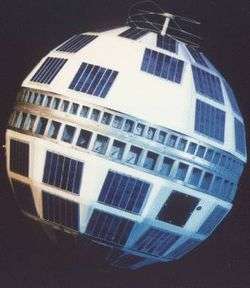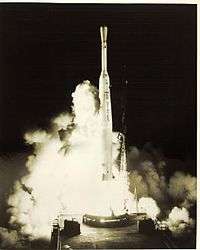Telstar 1
Telstar 1 was a communications satellite launched by NASA on July 10, 1962, it was the satellite that allowed the first live broadcast of television images between the United States and Europe. It remained active for only 7 months, a much shorter service life than today's artificial satellites. Although it no longer works, it is still in Earth orbit.
 The original Telstar had a roughly spherical shape. | |
| Operator | AT&T / NASA |
|---|---|
| COSPAR ID | 1962-029A[1] |
| SATCAT no. | 340 |
| Spacecraft properties | |
| Manufacturer | Bell Labs |
| Launch mass | 171 kilograms (377 lb) |
| Start of mission | |
| Launch date | 08:35:00, July 10, 1962 (UTC) |
| Rocket | Thor-Delta |
| Launch site | Cape Canaveral LC-17B |
| End of mission | |
| Deactivated | February 21, 1963 |
| Orbital parameters | |
| Reference system | Geocentric |
| Regime | Medium Earth |
| Perigee altitude | 952 kilometers (592 mi) |
| Apogee altitude | 5,933 kilometers (3,687 mi) |
| Inclination | 44.8° |
| Period | 2 hours and 37 minutes |
| Epoch | 1962-07-10 08:35:00 UTC |
History


The idea of transmitting information by means of satellites was hardly new. As early as October 1945, the mathematician and visionary Arthur C. Clarke published an article talking about it in the specialized magazine Wireless World. His idea was to take advantage of the immensity of space to transmit information, using a satellite system for this purpose. During the Cold War, the shock caused by the successful launch of the first artificial satellite, Sputnik 1, by the Soviets increased the United States' interest in aerospace research. Soon thereafter, the Americans began their attempts to launch orbital communications satellites for transmitting telephone, radio, and television signals.[3]
In December 1958, the United States successfully launched its first communications satellite, SCORE. Through it, then-President Dwight D. Eisenhower sent a Christmas message to the entire world. However, SCORE stayed in orbit for only a few months, its enormous surface and very low Earth orbit forcing reentry after only 500 laps around the planet. Also, SCORE relied on a passive reflector, which greatly reduced signal strength.
Launch
Telstar 1 was launched on July 10, 1962 from the Cape Canaveral Air Force Station, Florida, atop a Delta rocket. Spherical in shape, the satellite had a diameter of 88 centimeters and weighed 77 pounds (35 kg).
Operations
A 53-meter terrestrial antenna manufactured by AT&T Corporation, located in Andover, Maine, was used for the transmissions between the U.S. and Europe. Built in 1961, and used by Telstar 1, it was later used by Relay 1. Telstar 1 operated normally from launch until November 1962 when the radiation from the Starfish Prime detonation affected the command channel, which began to behave erratically. The satellite was continuously switched on to work around this problem. On November 23, 1962, the command channel stopped responding. On December 20, the satellite was successfully reactivated, and intermittent data were obtained until February 21, 1963, when the transmitter failed. The energy used by it was produced by 3,600 solar cells. The satellite relied on an active repeater and magnified signal strength by a factor of a hundred using a TWTA. Thirteen days after the launch, the first live broadcast of a television show between the United States and Europe took place.[4]
Germany was one of the countries that participated in the broadcasts, with live footage showing workers at a blast furnace in the industrial area of Duisburg, located in the west of the country. The images were extremely bad by today's standards.
The live images of New York City and the Golden Gate bridge were of similarly poor quality, but at least they gave the sensational impression of watching an event on the other side of the world. In addition, the transmissions were not continuous, being restricted to 30 minutes, since the low orbit of the satellite made it difficult for the receiving and transmitting antennas to pick up its signal. Its 2¼-W transmitter had such weak signals that the ground stations had to magnify them 10 billion times through 30-m-diameter parabolic antennas.
Since this time, thousands of satellites have been launched in Earth orbit, mostly for military, scientific and telecommunications purposes.
References
- NASA, Goddard Space Flight Center. "Telstar 1". National Space Science Data Center Master Catalog. Retrieved May 31, 2018.
- "Felker Talking Telstar". WNYC. Retrieved 2016-10-31.
- DW. "1962: Nasa lança ao espaço o primeiro satélite de comunicações" (in Portuguese). Retrieved May 31, 2018.
- Dalgleish, 1989. "An Introduction to Satellite Communications". books.google.co.uk. Retrieved May 31, 2018.